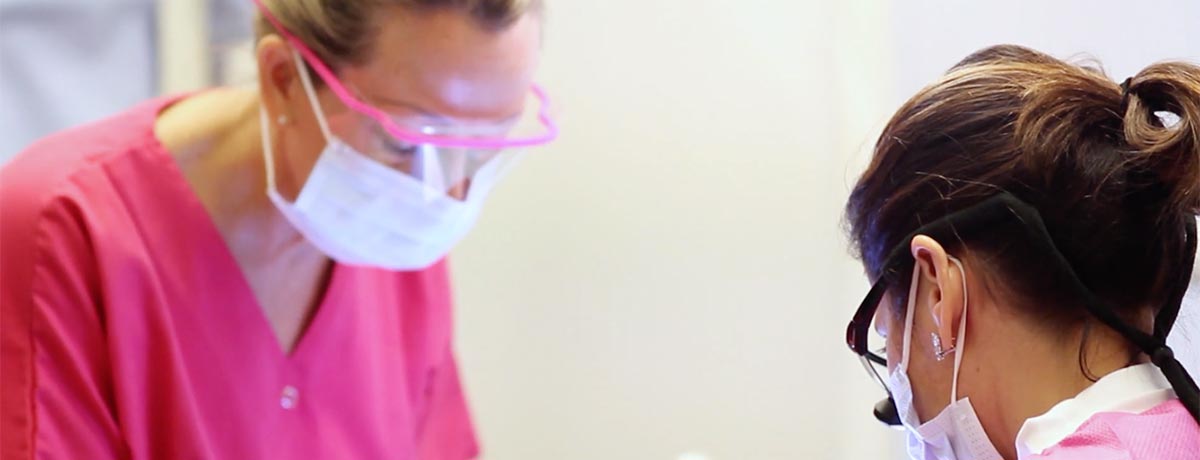General Dentistry

During an oral examination, a visual inspection is performed to detect normal and abnormal structures of the entire mouth, head and neck. Along with radiographs, an examination detects cavities, abnormalities in existing dental restorations, gum and bone recession and any other abnormal findings within the mouth, head and neck. Also included in the oral examination is a thorough oral cancer screening to check for any oral tissue inconsistencies and/or lesions.
A dental cleaning, also known as an oral prophylaxis, is the removal of dental plaque and tartar (calculus) from the teeth. Specialized instruments are used to gently remove these deposits without harming the teeth. First, an ultrasonic device that emits vibrations and is cooled by water is used to loosen larger pieces of tartar. Next, hand tools are used to manually remove smaller deposits and smooth the tooth surfaces. Once all the tooth surfaces have been cleaned of tartar and plaque, the teeth are polished.
These removable acrylic appliances are intended to relieve temporomandibular joint pain and other effects of grinding the teeth (bruxism). Day Guards are thinner, less bulky mouthpieces that can help alleviate teeth grinding during the day, while Night Guards are thicker, softer mouthpieces intended for wearing while sleeping.
Our primary goal is to save your natural teeth whenever possible. When root canal therapy is performed, the pulp chamber of the tooth is removed and then filled with a suitable filling material. Root canals are most often necessary when decay has reached the nerve of the tooth or the tooth has become infected. People have anywhere from 1 to 4 canals in a tooth. Extra canals may branch out and are called “accessory canals.” The number of canals and anatomy of a tooth can vary.
Aesthetic Dentistry

Whitening, also known as bleaching, is the procedure used to brighten teeth. There are two different ways to achieve a desired whiter smile, Chairside Bleaching and Take Home Bleaching.
Chairside Whitening usually requires only one office visit. A protective gel or a rubber shield is placed over the gums to protect the soft tissue. A bleaching agent containing carbamide peroxide is applied to the teeth, and a laser light is then used to enhance the action of the whitening agent .
Take Home whitening requires an impression of the teeth to be taken to make a customized mouth guard to hold the whitening gel, containing carbamide peroxide, against the teeth. Once the mouth guard is made, it is worn for a period of time, generally from a couple of hours a day to every day during the night for up to four weeks or longer, if desired.
Using transparent aligners that have been custom made for your teeth, Clear Aligners (Minor Tooth Movement®) work to correct small imperfections in your smile, such as crowding and gaps. A set of aligners will be created to slowly change the position of your teeth, leaving you with a beautiful smile at a fraction of traditional braces.
Invisalign® takes a modern approach to straightening teeth, using a custom-made series of aligners created for you and only you. These aligner trays are made of smooth, comfortable and virtually invisible plastic that you wear over your teeth. Wearing the aligners will gradually and gently shift your teeth into place, based on the exact movements your dentist or orthodontist plans out for you. There are no metal brackets to attach and no wires to tighten. You just pop in a new set of aligners approximately every two weeks, until your treatment is complete. You’ll achieve a great smile with little interference in your daily life. The best part about the whole process is that most people won’t even know you’re straightening your teeth.
An inlay or onlay is a partial crown restoration that can be placed when there is not sufficient tooth structure to support a filling, but not quite large enough to require a crown. They are made of a composite or porcelain that aesthetically replaces the missing tooth structure.
After cavities are cleaned, a composite filling is used to “patch up” the cavity that bacteria leave behind when they infect the tooth. Composite fillings are safe and shaded to match the color of the tooth.
Complete (Full) Dentures are made after all the teeth in the mouth have been removed and the gum tissue has healed. The denture includes an acrylic base that is custom made in the dental laboratory and are made to look like natural gums, which sits over the gums or can be anchored to dental implants.
Partial Dentures are made only when a few teeth need to be replaced. The partial denture either attaches to crowns on either side of the denture or to a metal framework that is attached to the teeth on both sides of the partial denture. Partial dentures can be removable or they can be anchored in place by attaching them to dental implants.
Implant Restorations

Periodontics

